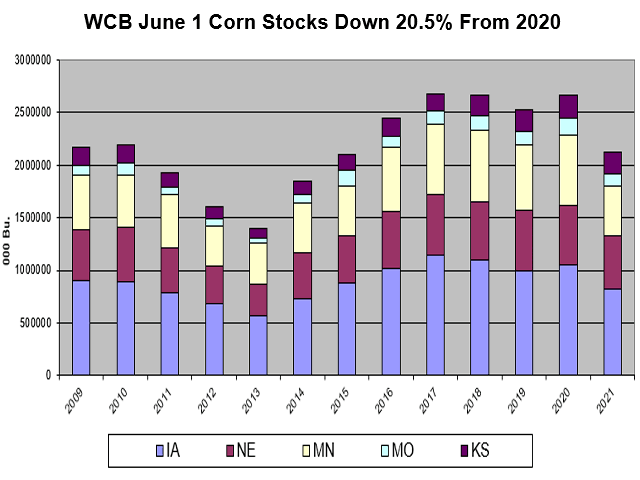Corn Stocks Hidden in Shadows
USDA Quarterly Grain Stocks Report and Implied Basis Levels
The folks at NASS unleashed two reports Wednesday, June 30 -- the quarterly Grain Stocks and the Planted Acreage. As you know by now, the net impact was a limit-up corn market Wednesday (with expanded 60-cent limits Thursday) and soybean futures very near the new daily limit of $1.00 per bushel with 90-cent gains.
The Planted Acreage report garnered most of the press and controversy. USDA's numbers were well below most trade estimates and implied producers pretty much ignored the $2.96 spring rally in soybeans (March report to June 7 high) and the simultaneous rally in corn. The controversy came from USDA finally letting everyone know they had changed the definition of Principal Crop acres back in 2019, and thus all of the historical data they provide to analysts was too high relative to what we might expect to see in 2021.
This sounds like fertile ground for additional analysis, but several other pieces on DTN have looked at the Planted Acres. If we're going to be tighter on new-crop supplies, that makes the bird in the hand (old-crop stocks) more valuable than the proverbial two in the bush. We need to look at those grain stocks numbers and implied basis levels a little closer -- those are bushels already in the bin before harvest starts.
P[L1] D[0x0] M[300x250] OOP[F] ADUNIT[] T[]
USDA revised their March stocks estimate by 5 million bushels (mb) to 7.696 billion bushels (bb), tightening stocks another quarter turn before looking at March-May (third quarter) use. The third-quarter use is thought to have been record large at 3.59 bb and a rounding error above 2018. Unlike 2018, exports were over a billion bushels for the quarter, crowding out some feed and residual use in the balance sheet. Ethanol use was up for the quarter -- quite a bit compared to last year's COVID-19 hobbled performance -- but didn't really hit full stride until the end of the period.
The record consumption for the quarter wasn't uniform across the country. Disappearance in the Western Corn Belt (Iowa, Nebraska, Kansas, Missouri and Minnesota by our definition) was up 31% from the previous year at 1.738 bb for the quarter. Combined with production changes, that left June 1 stocks in the Western Corn Belt 20.5% tighter than the previous year and justifies a stronger basis.
For the Eastern Corn Belt (Ohio, Indiana and Illinois in our historical definition), disappearance was only 9.2% larger than last year at 970 mb. Combined with production changes, that left June 1 stocks in the Eastern Corn Belt 8.4% smaller than year ago. Again, that points toward a tight national and regional basis bid.
Cash corn prices for the U.S. peaked in early May. Basis bids were stronger against July, because it was at a discount to where May went off the board. However, the equivalent cash price was lower. Current basis bids are, on average, about 15 cents above the long-term average for this date, with most elevators having already moved to the September contract to avoid any futures price squeezes during delivery (and the lack of liquidity to get out of hedges gracefully during the delivery period).
The NASS data also shows the percentage of corn held on farm as of June 1 is way down, by 39.2%, versus a year ago. Off-farm stocks are 10.9% larger than a year ago. While ownership of stocks in those two positions isn't clear, we know that 1) elevators have a lot of corn in house to meet end user and export needs, and 2) If end users like ethanol plants or feedlots need to go buy corn, there isn't much available until new crop hits the distribution channels. Should there be yield issues with new crop, a scramble could still develop to acquire the remaining old-crop bushels. Whether that is on top of higher futures or a push because futures stall out remains to be seen.
Alan Brugler may be reached at alanb@bruglermktg.com
(c) Copyright 2021 DTN, LLC. All rights reserved.




